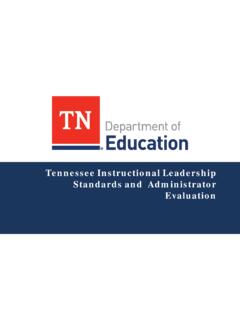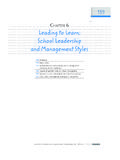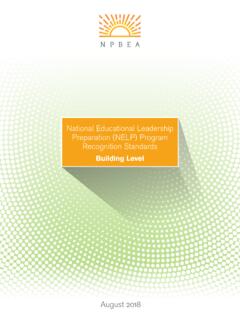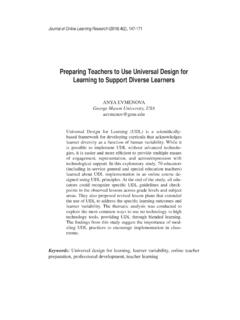Transcription of Instructional and Transformational Leadership: Burns, Bass ...
1 Canadian Journal of Educational Administration and Policy, Issue #54, June 26, 2006. 2006 by CJEAP and the author(s). Transformational leadership : An Evolving Concept Examined through the Works of Burns, Bass, Avolio, and Leithwood Jan StewartUniversity of Winnipeg Abstract Over the past four decades, the concept of leadership has become increasingly more complex and elaborate. Considerable debate has emerged over the most suitable model for educational leadership . Dominating the literature are two conceptual models: Instructional leadership and Transformational leadership . This paper will review the conceptual and empirical development of Transformational leadership as it evolved through the work of James MacGregor Burns, Bernard M. Bass, Bruce J. Avolio, and Kenneth Leithwood. Moreover, the paper will discuss some of the conflicting opinions and diverging perspectives from many of the critics of Transformational leadership .
2 The author argues that Transformational leadership will continue to evolve in order to adequately respond to the changing needs of schools in the context of educational accountability and school reform. 1 Canadian Journal of Educational Administration and Policy, Issue #54, June 26, 2006. 2006 by CJEAP and the author(s). Introduction Where do we come from? What are we? Where are we going? Although these three simple questions originally posed by Paul Gauguin in the late 1800s were intended to provide meaning to human existence, they do offer a simple analogy to delve into the mysteries and ambiguities of leadership . The following discussion of leadership involves an examination of emerging themes, evolving models and empirical research from some of the most well-known leadership scholars.
3 So as not to develop a myopic view of leadership , theorists from outside of the field of educational administration are discussed and numerous similarities are drawn. The paper will examine some of the conflicting opinions and diverging perspectives of leadership and discuss the overriding debate concerning the most suitable educational leadership model. Who are educational leaders? Are they celebrity CEOs who focus on soliciting public support instead of increasing profits? Are they altruistic individuals committed to the overall organization and the betterment of our children? In what direction are schools going? How will educational leaders navigate others within a culture that fully embraces systemic change? Robert Wright (2004), author of bestselling book, A Short History of Progress, asserts that we have progressed so rapidly as a society that the skills and customs we learned as children are outdated by the time we are thirty.
4 In a sense, we struggle to keep up with our own culture. In hunter-gatherer societies the social structure was, for the most part, egalitarian. leadership was diffuse, a matter of consensus, or something earned by merit or example (Wright, p. 48). When the hunter was successful he shared his meat and thus gained power and prestige from his followers. leadership is a universal phenomenon. The roles of both leaders and followers have become more complex and elaborate and multiple perspectives exist on how leadership is conceptualized. Leithwood and Duke (1999) conducted a review of the concepts of leadership in educational literature from 1988 to 1995. In this review they found a total of 121 articles on leadership , out of a total number of 716 articles.
5 Based on a review of ten years of leadership research, by top scholars in educational administration, Heck and Hallinger (1999) concluded that there was a clear trend toward the accumulation of knowledge regarding school leadership and its effects. leadership has been, and will continue to be, a major focus in the era of school accountability and school restructuring. They also suggest that the study of school leadership will become increasingly more eclectic, both philosophically and methodologically. In addition, 2 Canadian Journal of Educational Administration and Policy, Issue #54, June 26, 2006. 2006 by CJEAP and the author(s). leading and managing effective schools to respond to the increasingly complex demands of society will require the knowledge and technical skills of committed and competent leaders.
6 With the plethora of research on the topic of leadership , we continue to see ambiguous and ill-defined concepts and theories on the topic of leadership . The all encompassing topic of leadership has subsumed such a diversity of perspectives and topics, that hardly anyone can determine what leadership actually is, nor how it should be defined. Furthermore, as the demographics shift, there is considerable debate on how to best prepare the next generation of leaders. The eclecticism reflected in the study of educational leadership has rendered the field unfocused and without a guiding purpose. Moreover, this has left scholars and practitioners searching to make sense of the field within a rapidly changing and diverse world.
7 There is no doubt that there will continue to be a focus on leadership throughout the succeeding decades. Michael Fullan (2001) claims that effective leadership is in short supply. He further adds that we should expect to see leadership development initiatives dominating the scene over the next decade (p. xii). What is the image of leadership that will take us through this period of organizational change and school reform? Moreover, what kind of leadership is needed at all levels of the school system to effectively lead us through change and advance us even further than we ever thought possible? The media inundate us with stories of top leaders in business, government, and education. Harvard Business Review and Educational Administration Quarterly, two of the most scholarly journals representing their respective fields, devote considerable space to the study of leadership .
8 Bestselling national book lists include books that examine all facets of leadership by well-known business writers such as: Jim Collins, Jack Welsh, and Peter Drucker. Our society has a growing desire to look more critically at our leaders as we search for more effective and efficient ways to run our organizations. Foster and Young (2004) note, When goals are not met, people lose confidence in, and tend to blame those people believed to be responsible for leadership (p. 29). School systems have become a source of blame for the many ills that affect our current society. The trend, as Young and Foster outline, is to blame those people believed to be responsible for leadership when solutions are not readily forthcoming (p. 29). Rarely does a day pass without newspapers reporting stories about both effective and ineffective leadership .
9 Society celebrates and often immortalizes outstanding leaders. Some people spend their lives trying to emulate and master the behaviours of these well-known leaders. The media regales in delight to share with us 3 Canadian Journal of Educational Administration and Policy, Issue #54, June 26, 2006. 2006 by CJEAP and the author(s). the demise of someone we thought was an infallible leader. Sometimes we hear of stories about ordinary people in a community who possess outstanding leadership qualities that mobilize others to work collaboratively towards achieving a common goal. Articles and books centre around helping people become more effective leaders: to be more innovative; to connect with their staff; and to develop and focus on a shared vision. Collectively, this abundance of literature attempts to explore the multidimensional and complex meaning of the term leadership .
10 Despite the copious amount of literature on leadership , an agreed upon definition of leadership does not exist. It is difficult to engage in conversation without a clear definition of what you are talking about; similarly, it is difficult to follow a concise definition of a concept that is so subjective. In addition to the ambiguity surrounding the definition of leadership , researchers have found relatively limited correlations between student learning and leadership practices. Leithwood and Riehl (2003) stated, Although leadership explains only about three to five percent of the variation in student learning across schools, this effect is actually nearly one-quarter of the total effect of all school factors (p. 3). Despite the seemingly limited correlation, the effect of leadership when compared to all of the other school factors proves to be substantial and therefore warrants consideration.
















